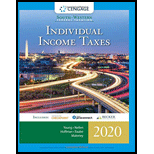
Individual Income Taxes
43rd Edition
ISBN: 9780357109731
Author: Hoffman
Publisher: CENGAGE LEARNING - CONSIGNMENT
expand_more
expand_more
format_list_bulleted
Question
Chapter 14, Problem 1RP
a.
To determine
Explain the tax consequences to Person TE.
b.
To determine
Explain the tax consequences to Person TE if the fair market value of the property is $2,525,000 and $25,000 has been received from the creditor.
Expert Solution & Answer
Want to see the full answer?
Check out a sample textbook solution
Students have asked these similar questions
Find the following value solve this question financial accounting
City Honda has total equity of $560,000; sales of $2,250,000; current assets of $700,000; and total liabilities of $435,000. What is City Honda's total asset turnover?
Riverside manufacturing estimated solve this general accounting question
Chapter 14 Solutions
Individual Income Taxes
Ch. 14 - Prob. 1DQCh. 14 - Prob. 2DQCh. 14 - Prob. 3DQCh. 14 - Prob. 4DQCh. 14 - LO.1 Taylor is negotiating to buy some land. Under...Ch. 14 - Prob. 6DQCh. 14 - Prob. 7DQCh. 14 - Prob. 8DQCh. 14 - Prob. 9DQCh. 14 - Prob. 10DQ
Ch. 14 - Prob. 11DQCh. 14 - Prob. 12DQCh. 14 - Prob. 13DQCh. 14 - LO.4 Marilyn owns land that she acquired three...Ch. 14 - Prob. 15DQCh. 14 - Prob. 16CECh. 14 - Prob. 17CECh. 14 - Prob. 18CECh. 14 - Prob. 19CECh. 14 - Prob. 20CECh. 14 - Heather owns 400 shares of Diego Corporation...Ch. 14 - Prob. 22CECh. 14 - Prob. 23CECh. 14 - Prob. 24CECh. 14 - Prob. 25CECh. 14 - Prob. 26CECh. 14 - Prob. 27CECh. 14 - LO.1 Anne sold her home for 290,000 in 2019....Ch. 14 - Prob. 29PCh. 14 - Prob. 30PCh. 14 - Nissa owns a building (adjusted basis of 600,000...Ch. 14 - Prob. 32PCh. 14 - Prob. 33PCh. 14 - Prob. 34PCh. 14 - Prob. 35PCh. 14 - Yancys personal residence is condemned as part of...Ch. 14 - Prob. 37PCh. 14 - Prob. 38PCh. 14 - Kevin purchases 1,000 shares of Bluebird...Ch. 14 - Prob. 40PCh. 14 - Prob. 41PCh. 14 - Prob. 42PCh. 14 - Nicky receives a car from Sam as a gift. Sam paid...Ch. 14 - Prob. 44PCh. 14 - Prob. 45PCh. 14 - Prob. 46PCh. 14 - Prob. 47PCh. 14 - Prob. 48PCh. 14 - Helene and Pauline are twin sisters who live in...Ch. 14 - Prob. 50PCh. 14 - Prob. 51PCh. 14 - Prob. 52PCh. 14 - Prob. 53PCh. 14 - Prob. 54PCh. 14 - Prob. 55PCh. 14 - Prob. 56PCh. 14 - Alton Newman, age 67, is married and files a joint...Ch. 14 - John Benson, age 40, is single. His Social...Ch. 14 - Prob. 1RPCh. 14 - Prob. 2RPCh. 14 - Prob. 5RPCh. 14 - Prob. 1CPACh. 14 - Prob. 2CPACh. 14 - Prob. 3CPACh. 14 - Prob. 4CPACh. 14 - Prob. 5CPACh. 14 - Prob. 6CPACh. 14 - Prob. 7CPACh. 14 - Prob. 8CPACh. 14 - Prob. 9CPA
Knowledge Booster
Similar questions
- Indiana Corporation products a single product that it sells for $9 per unit. During the first year of operations, 100,000 units were produced, and 90,000 units were sold. Manufacturing costs and selling and administrative expenses for the year were as follows: Raw materials Direct labor Factory overhead Fixed Costs Variable Costs $1.75 per unit produced $1.25 per unit produced $1,00,000 $0.50 per unit produced Selling and administrative $ 70,000 $0.60 per unit sold What was Indiana Corporation's net operating income for the year using variable costing? A. $371,000 B. $281,000 C. $271,000 D. $181,000arrow_forwardGiven the information below, what is the gross profit on these general accounting question?arrow_forwardExplore the concept of accounting flexibility and its impact on the reliability and usefulness of financial information. While adaptability in accounting methods can allow organizations to better reflect their unique circumstances, it may also introduce the risk of selective application or manipulation. Discuss the appropriate balance between standardization and customization in accounting practices, and the safeguards that can be implemented to preserve the integrity of financial reporting.arrow_forward
- Beginning inventory was $4,000, purchases totaled $31,000, and sales were $20,000. What is the ending inventory?arrow_forwardIris Company has provided the following information regarding two of its items of inventory at year-end: There are 200 units of Item A, having a cost of $10 per unit, a selling price of $14 and a cost to sell of $6 per unit. There are 150 units of Item B, having a cost of $40 per unit, a selling price of $46 and a cost to sell of $4 per unit. How much is the ending inventory using lower of cost or net realizable value on an item-by-item basis? a. $8,350. b. $8,750. c. $8,000. d. $7,600.arrow_forwardProvide answer this general Accounting questionarrow_forward
arrow_back_ios
SEE MORE QUESTIONS
arrow_forward_ios
Recommended textbooks for you
 Individual Income TaxesAccountingISBN:9780357109731Author:HoffmanPublisher:CENGAGE LEARNING - CONSIGNMENT
Individual Income TaxesAccountingISBN:9780357109731Author:HoffmanPublisher:CENGAGE LEARNING - CONSIGNMENT




Individual Income Taxes
Accounting
ISBN:9780357109731
Author:Hoffman
Publisher:CENGAGE LEARNING - CONSIGNMENT

